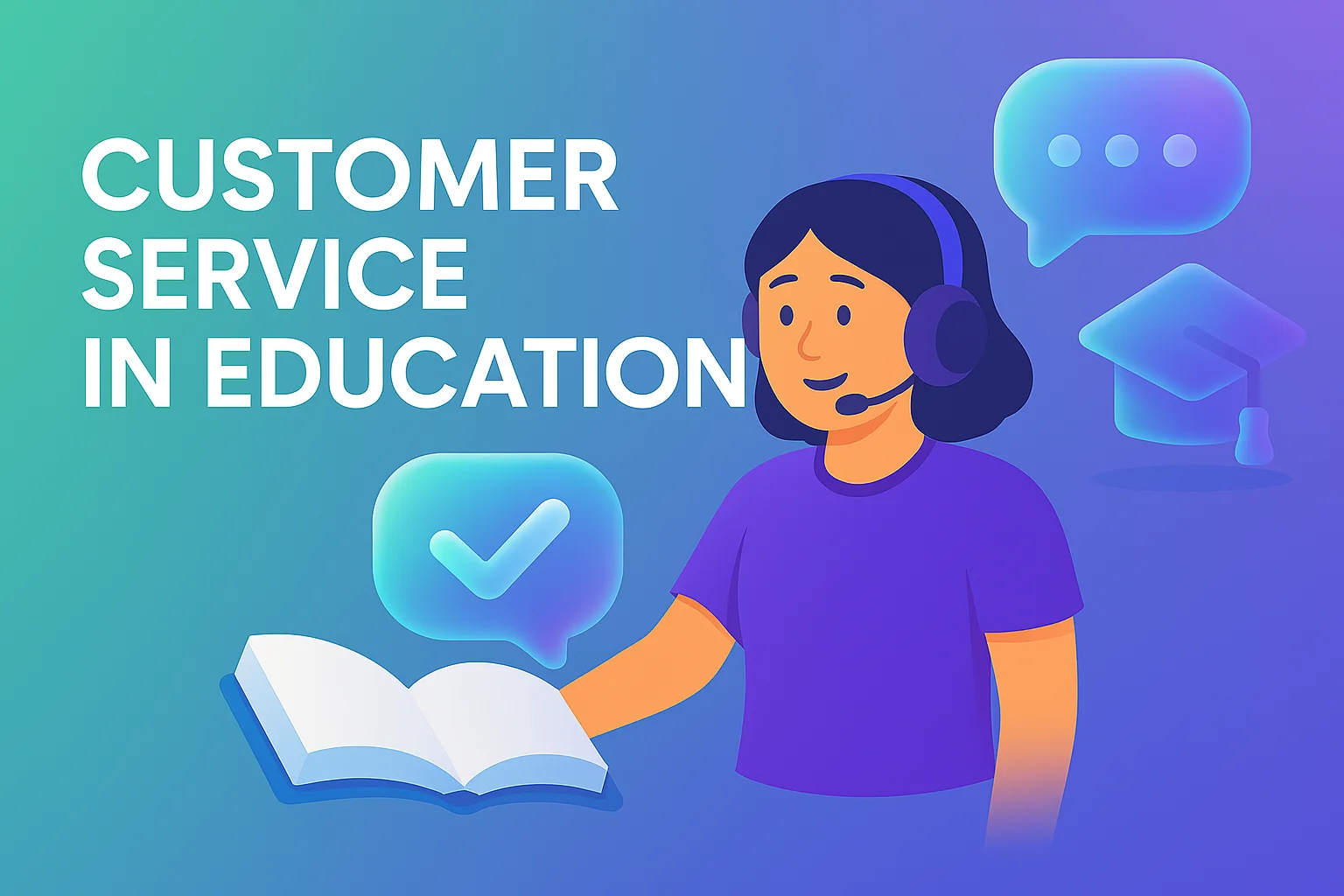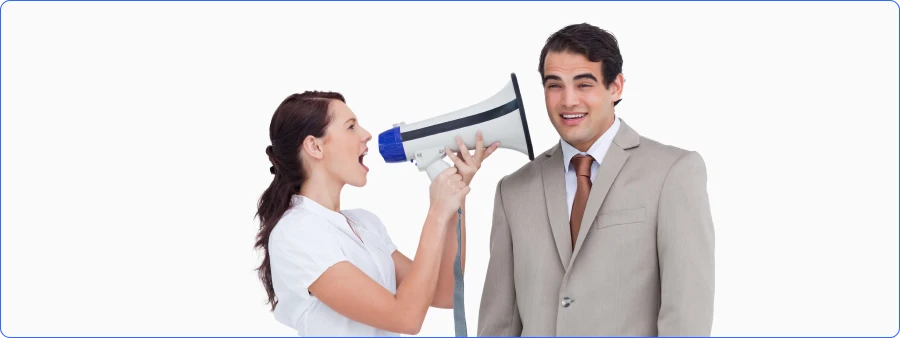What is a Customer Profile? Types, Examples and Templates
- June 5, 2023
- 19 mins read
- Listen

Customers expect personalized experiences at each stage of the journey with a brand. They feel happy when the experience provided to them comes with a touch of personalization. However, serving customers effectively and meeting their needs successfully is easier said than done. Most businesses spend a big budget on marketing but face unqualified traffic and leads. To avoid this kind of situation, it’s important to focus on who to target.
This is where customer profiles help – they are designed to help businesses understand their ideal customers. These profiles prove vital in marketing, sales, and offering support to the right customers. Using a customer profile, your company can craft messages and spend the marketing budget in a way that reaches the right audience and meets their needs.
In this blog, we will explore and understand everything about a customer profile, and know its definition, benefits, and steps to create an ideal profile for your business.
But first, let’s get started with understanding what exactly a customer profile is…
What is a Customer Profile?
A customer profile is a document or detailed description of an ideal or typical customer. It also serves as a strategic guide to understanding the customers better and creating personalized experiences for them.

Such profiles carry information about customer interests, demographic data, buying patterns, pain points, etc., which prove helpful in how customers engage with your brands or products.
A customer profile is also an ideal representation of the traits, characteristics, motivations, and behaviors of a particular group of target audiences. That’s why they are key to not only understanding but also catering to the needs and preferences of customers.
What is Customer Profiling?
Customer profiling is the process of creating customer profiles. Companies use this process to create detailed descriptions of their ideal target audience. It involves collecting and analyzing data to understand the preferences and needs of different customer segments. The main purpose of customer profiling is to create a clear picture of the types of individuals that are likely to purchase from a company.
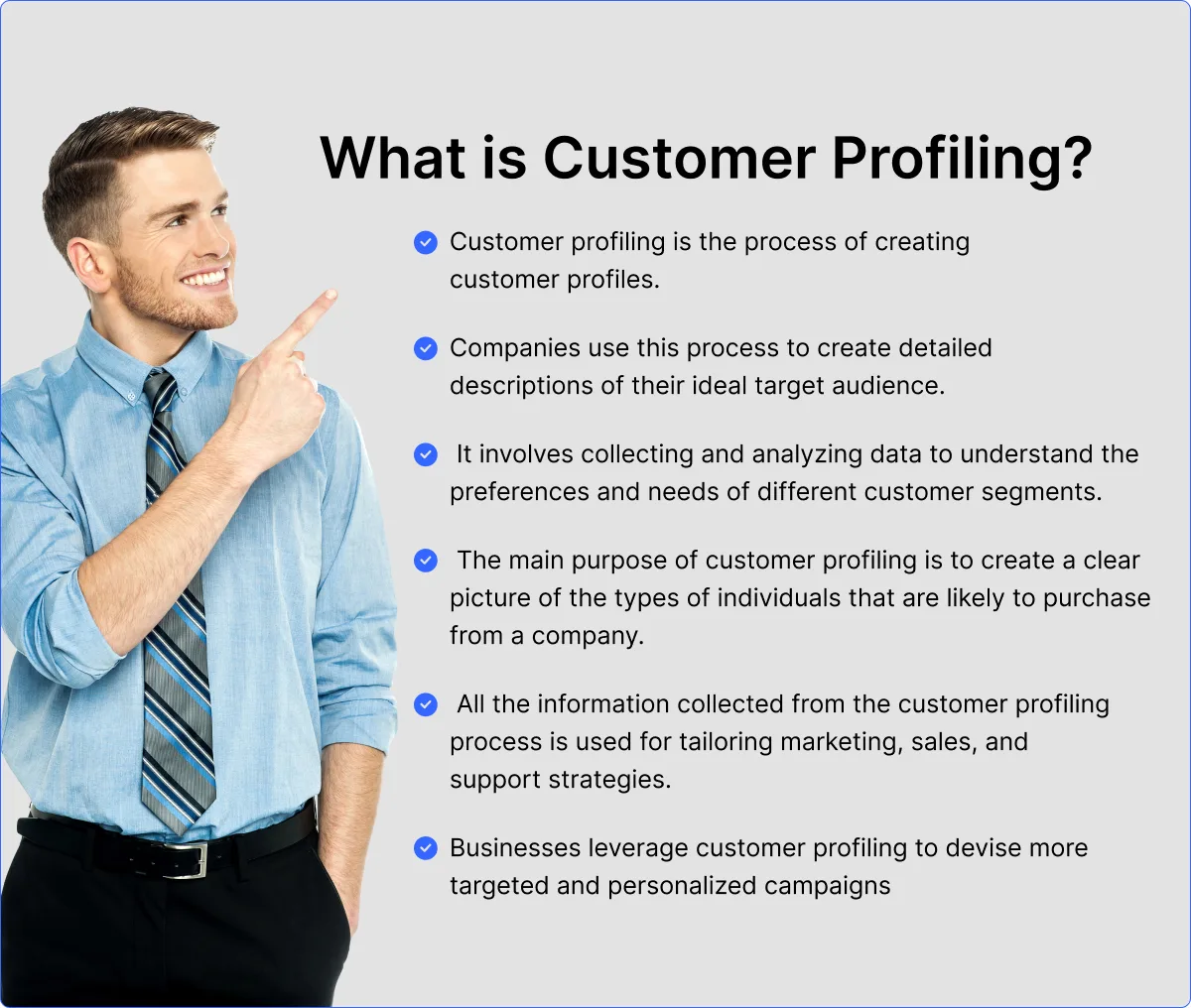
All the information collected from the customer profiling process is used for tailoring marketing, sales, and support strategies. This is how a business is able to effectively engage with the target audience. Businesses leverage customer profiling to devise more targeted and personalized campaigns, enhance customer satisfaction, and ultimately drive customer loyalty and retention. In a nutshell, this process is key to staying responsive to the ever-changing needs of the target audience…
B2B vs B2C Customer Profiles
There are two distinct types of customer profiles – B2B (business-to-business) and B2C (business-to-consumer) customer profiles. Understanding the differences between both types of customer profiles is key to reaching and engaging with the respective target audiences.
- B2B customer profiles – These profiles represent the various types of businesses that engage with your products or services. Detailed knowledge of B2B customer profiles is vital to ensuring effective marketing and business development strategies. Such profiles map the various aspects of a business, including its target audience, location, size, and industry. The main focus of B2B customer profiles is mostly on businesses but sometimes also on the decision-makers at the top.
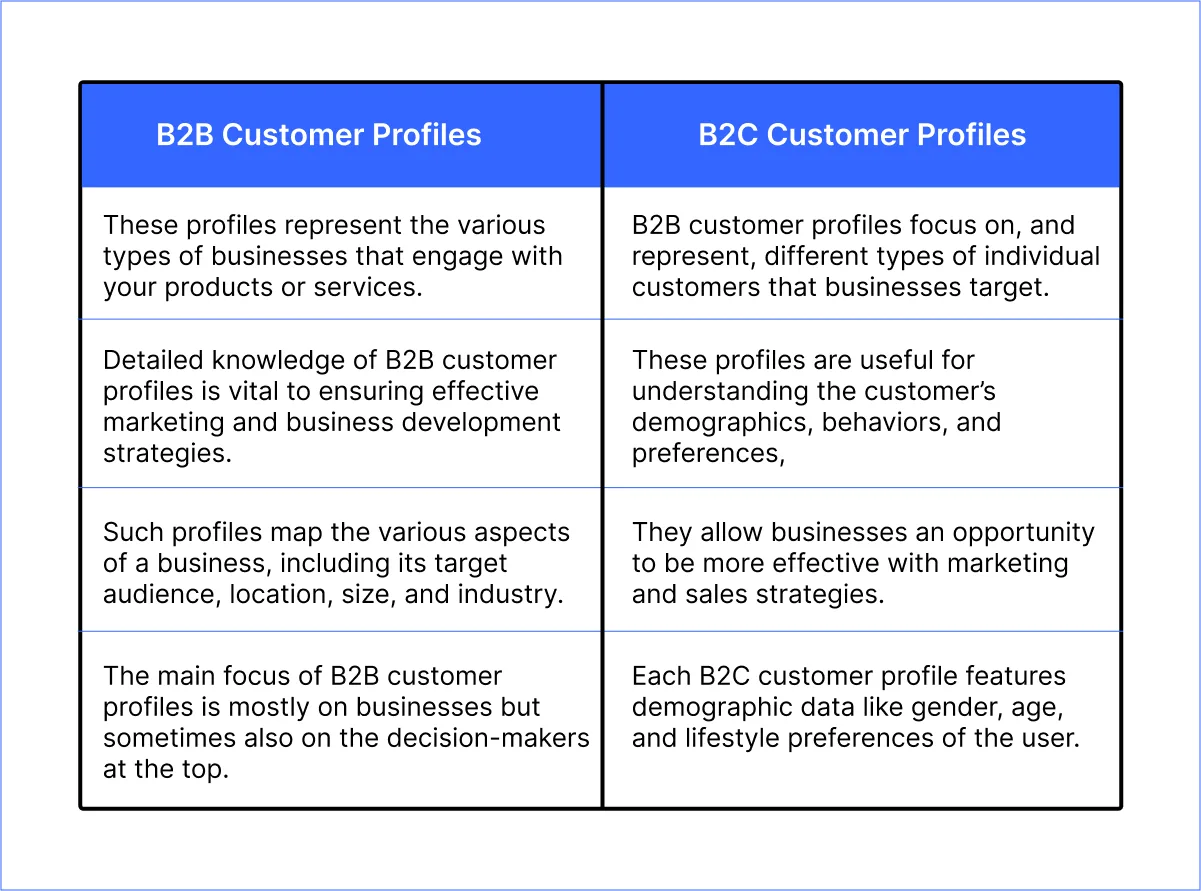
- B2C customer profiles – B2C customer profiles focus on, and represent, different types of individual customers that businesses target. These profiles are useful for understanding the customer’s demographics, behaviors, and preferences, therefore allowing businesses an opportunity to be more effective with marketing and sales strategies. Each B2C customer profile features demographic data like gender, age, and lifestyle preferences of the user.
Different Types of Customer Profiles
Businesses can create different types of customer profiles based on specific objectives and criteria. Industry-specific customer profiles can also be created to better create marketing messages and enhance the value of experiences for customers.

The different types of customer profiles include –
- Demographic Profiles – These profiles are created to understand the basic background of the customers. Some of the key characteristics used in these profiles include age, gender, occupation, education, and marital status.
- Psychographic Profiles – This type of profile gives deep insights into customers’ preferences, behaviors, and buying habits. They focus on the hobbies, interests, motivations, values, and attitudes of the customer.
- Geographic Profiles – This type of profile is created to understand customers based on their geographic location such as the country, region, and city. Based on geographic information, a business can understand the factors that affect customer behavior in specific locations.
- Behavioral Profiles – The purpose of creating behavioral profiles is to understand customers’ past engagement and purchasing behavior with the business. The information thus collected can be used to identify patterns and trends related to customer behavior.
- Technographic Profiles – This type of customer profile is created to better understand customers’ technological habits and preferences. The key information collected includes the devices customers use, the social media platforms they hang out on most often, and the communication channel they prefer the most.
Difference Between a Customer Profile and a Buyer Persona
In the industry, many people use the terms “customer profile” and “buyer persona” interchangeably, assuming that both are the same. They, however, are not the same as each has distinct meanings and serves different purposes for a business’ marketing and sales efforts.
A customer profile offers a general view of the target audience while a buyer persona provides a more in-depth representation of individual customers within the target audience. While customer profiles tell us more about broader strategies, buyer personas convey more information about personalized tactics.

Let’s look at some of the key differences between a customer profile and a buyer persona –
1. Scope
- Customer Profile – It represents a broader view of the target audience and their demographics and characteristics. General information such as age, gender, and location is generally part of a customer profile.
- Buyer Persona – It is a specific representation of an ideal customer and the information it uses goes beyond demographics. A buyer persona gives a deeper knowledge of individual customers that make up the target audience.
2. Level of personalization
- Customer Profile – A customer profile is general and does not include preferences of any specific customer segment.
- Buyer Persona – A buyer persona will be personalized and include all the information that individualizes the target audience.
3. Purpose
- Customer Profile – The purpose of creating a customer profile is a get a broad understanding of the target audience and it’s mostly used in the early stages of devising marketing strategies.
- Buyer Persona – The purpose of creating a buyer persona is to get help at a granular level so that a business is able to create personalized messaging and campaigns.
4. Focus
- Customer Profile – A customer profile focuses on the general motivations and behaviors of customers and may not dig deeper into the details and factors influencing purchase decisions.
- Buyer Persona – A customer persona focuses on all the details that cause decision-making from individual customers.
Benefits of Customer Profile
Customer profiles are key for businesses to align their strategies with customer needs and expectations. They help organizations make informed decisions and forge fruitful relations with customers.

Creating and using custom profiles can offer a number of benefits to businesses, including –
- Targeted Marketing – A business that creates and utilizes customer profiles is able to effectively tailor its marketing efforts to specific customer segments. These profiles are key to creating personalized campaigns and marketing messages that can enhance the effectiveness of marketing strategies.
- Enhanced Customer Experience – By using customer profiles, a business can better understand customer needs and pain points, and this knowledge could prove crucial to customizing interactions and meeting expectations. When a business consistently delivers a personalized and tailored experience, it stands to gain happy customers who share such experiences with 6 or more people.
- Efficient Resource Allocation – A detailed understanding of customer segments, needs, and preferences is always helpful when it comes to focusing on the most relevant customer groups. This kind of focus can help minimize resource wastage and maximize ROI on marketing, sales, and development budget.
- Success with Product Development and Innovation – Businesses can leverage customer profile data to develop new products in a way that better meets customer preferences. When product development is aligned with the customer profile, it always boosts the chances of product success in the market.
- Improved Value Proposition – Using customer profiles is synonymous with having a better understanding of customers. This knowledge could prove essential in developing unique marketing strategies and improving the value proposition for customers. All this can give the business a competitive edge in the market.
Methods of Creating Ideal Customer Profiles
There are several methods that can be used to create ideal customer profiles. A business can use a combination of quantitative and qualitative research techniques to gain a deep knowledge of their customers.
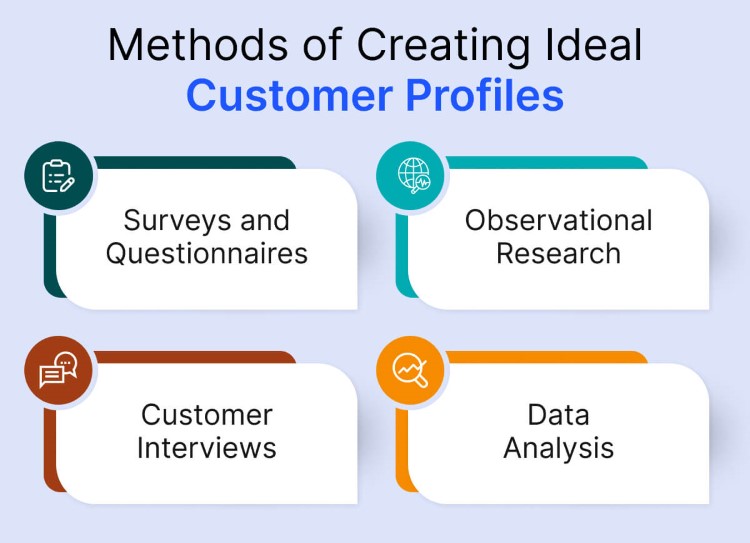
Here are the key methods for creating a customer profile –
- Surveys and Questionnaires – These methods are apt when it comes to collecting direct feedback from customers. A business can use emails, online forms, or physical interviews to do surveys and gather relevant customer data.
- Observational Research – A business can observe how customers engage and interact with their brand, products, or how they make purchasing decisions. Based on such observations, it’s possible to gain vital data about customer preferences and behavior.
- Customer Interviews – Interviews with existing customers are very helpful tools to gain in-depth qualitative information and understand customer pain points and motivations. Like an interview, organizing focus groups with customers can prove equally valuable for gaining key data and building accurate profiles of the audience.
- Data Analysis – Leveraging the existing customer data from various sources such as websites, social media, interactions, etc., could give deep insights. In fact, data analysis has long been a popular method to understand customer behavior and then use the information for creating profiles.
Steps to Create an Ideal Customer Profile
Creating an ideal customer profile relies on identifying your best customers and then learning about them. The profiling should be done before the sales prospecting and lead qualification stages so that it could be leveraged optimally.
Here is a step-by-step guide to creating a customer profile –
1. Use Customer Profile Templates
Pre-made customer profile templates are easy to find. They make the entire process of creating a profile easy and simple. When templates are used, there is not much to do except fill in the blanks based on the specific criteria for your business.
These profiles are very helpful when it comes to gathering and organizing information about your customers. With them, you can easily find a structured format to fill in relevant details about your audience and then cater to their needs.
More so, customer profile templates give a systematic approach to understanding the customers and then tailoring your marketing efforts accordingly. They can also help a lot with product development and ensuring quality with customer service.
2. Define Your Target Market
Defining the target market is a key step in creating an ideal customer profile. In this step, the focus is to identify and specify the individuals that are most likely to be interested in your product or service.

To define the target market, you need to understand many things, including –
- Get a clear understanding of your products, their features, benefits, and USP so that you can match them with what your target audience would be looking for.
- Analyze the demographics and purchase behavior of your existing customers, as this will give some patterns and trends in regard to your prospective customers.
- Do research and find out which demographic groups are likely to be interested in your product or service.
- Understand the preferences and motivations of your customers and see how your offers align with their values and lifestyle.
3. Conduct Market Research
The process of building a customer profile is not complete without market research. It helps you understand your target market better and collect valuable insights. You can collect tons of useful data about your industry, competitors, and potential customers.
More so, a business needs to regularly update and revisit its research to stay informed about market dynamics and industry trends. It will also help in understanding changed customer needs and preferences.
Conducting marketing research needs to involve various aspects, including –
- Always start the research with a clearly defined objective as it will help you gather the kind of data and customer information necessary for creating profiles.
- Choose a research method that best fits your objective, as there are different ways to research such as surveys, focus groups, interviews, etc.
4. Review Your Customer Journey Map
Using the customer journey map can help a lot when you start examining and analyzing your customer profile data. With a journey map, you will get a document that outlines every step and touchpoint that a customer may go through to meet their target with your company.

Reviewing a customer journey map can serve you well in understanding how and where customers engage and interact with your brand the most. This engagement will prove key when you design a customer profile. After all, 52% of marketers devise and adapt strategies based on customer interactions and feedback.
More so, a customer journey map can help you understand who you’re looking to target. You can also get a good knowledge of what your customer wants from your business, and how they felt at each step of the journey with the brand.
5. Study Customer Demographics in Detail
The purpose of creating a customer profile is to understand your prospects and align your products or service with their needs and expectations. To know the customer better, you can leverage your CRM tool and analytics tool and gain a deep insight into their behavior to some extent.
For a B2B business, key aspects of demographic data include –
- Location – Understand the location of your customer, where they are based, and whether their identity is local, regional, or national.
- Strength – How big your potential customer is, how many people are employed with them, etc.
- Revenue – Gain information on how much revenue they are generating as this piece of information will help you know the extent you can go to serve them better.
- Tools – It’s important to understand what tools they use and whether your product or software could be the value proposition they need.
6. Create a Behavioral Profile of Your Customer
When all the data and insights are collected, you can go ahead with the review process. The purpose is to review and analyze the data compiled thus far and create a behavioral profile of your ideal customer.
By looking at the data, you will find patterns and commonalities that can give a peek into your ideal customer base. Before building the profile, make sure you have sorted the list and found a similar set of customers, and grouped them based on common traits.
Now, you can name each segment and highlight the common traits that appear most often.
7. Compare with Customer Profile Examples
Crafting an effective customer profile can be both exciting as well as challenging, depending on how you look at it. Once you create it, it will help you get a deep knowledge of the customer’s needs and behaviors.
This deep knowledge is a key purpose of creating a customer profile. Most businesses create customer profiles as they want their marketing and sales strategies to be effective.
This means you will easily find ideal customer profile examples with just a little search and then match and compare them with yours. This comparison can help you prepare a better profile and get improved results with your marketing efforts.
Common Customer Profiles Mistakes
Creating accurate customer profiles is key to effective marketing. When your customer profile is error-free and actionable, it can contribute to the success of your marketing strategies and customer engagement. However, mistakes may happen when you create customer profiles, and that can take away the desired level of accuracy and usefulness of these profiles.
Here are some common customer profile mistakes you should avoid –
Relying on assumptions rather than data
Data is vital when it comes to understanding customers better. When there is enough customer data, it becomes easy to know the preferences, behaviors, and demographics of the audience. However, sometimes assumptions are preferred over data where profiles are created without gathering customer data.
Not segmenting the customer audience on different criteria
Your target audience is never a homogenous group. Rather, it’s always made up of different segments with unique traits and characteristics. So, when you don’t segment the audience, you risk treating all customers as the same. On the other hand, segmenting the audience based on relevant traits can help you target them more specifically.

Not making a dynamic profile
We know how customer preferences evolve with time. There are changes in the market and industry trends, which also keep changing from time to time. So, ideally speaking, a customer profile should be dynamic to reflect and consider those changes. However, some businesses create static profiles that don’t reflect various changes in the market and audience.
Lack of collaboration across departments in data sharing
Ideal customer profiles are created when there is a seamless collaboration between different departments. Such profiles may look incomplete and may depict an unclear picture if made without inputs from other departments. So, the goal should be to involve all the departments and gather insights to create a customer profile that gives a complete understanding of the audience.
Not testing and validating data
Regularly testing and validating customer data brings accuracy and adds value to decisions. However, sometimes data is neither tested nor validated through surveys, A/B testing, or customer feedback. This ensures inaccuracy with the data, and when data is not accurate, how can customer profiles depict a real scenario?
Why Use Customer Profile Templates?
Customer profile templates are very helpful for businesses to understand and categorize their customers. They serve as a roadmap to knowing the customers better and engaging with them effectively.
Using customer profile templates can help your business in many ways, including –
- Templates are used to gather and organize essential information about customers, and this data helps a lot in tailoring products or services to meet the specific customer needs.
- Using templates helps create detailed profiles, which allows personalizing marketing efforts.

- The use of customer profile templates gives a foundation for data analysis and decision-making.
- When templates are used, they provide guidance about the kind of customer information to collect, and this saves mistakes from the team
- Templates ensure that you don’t have to create a new customer profile every time for marketing and sales strategies, and this saves time and resources
3 Customer Profile Templates You Can Use
Here are some customer profile templates you can use –
1. Basic customer profile template

As the name suggests, a basic customer profile template is easy to understand, and it becomes ideal for a business that has not created a profile before. Obviously, this type of profile will include the basic information, i.e. the most important details. The information it contains includes the customer’s age, location, and interests. It also includes the customer’s preferred communication channels.
2. B2B customer profile template
A B2B customer profile template offers space to add key details about your ideal B2B customers. Such templates use info such as business size, location, revenue, solutions, strengths, and weaknesses. Using this type of template, a business can target the audience in a strategic manner.
3. Ideal customer profile (ICP) template

This type of template is suitable for using a scoring system to analyze the potential fit of a customer. It includes all the information that helps in the assessment of a customer’s suitability for the business. It includes different categories for preferences, needs, timelines, and budgets.
Customer Profile Examples
Customer profiles can come in different forms. Here are some customer profile examples –
- Basic customer profile
- Ideal customer profile

How To Gain Useful Data for Your Customer Profiles
Creating ideal customer profiles is easy when your business has useful data at hand. In fact, you can create a better customer profile when you track and analyze customer interactions and engagement at each stage of the journey.
At REVE Chat, we understand the huge value of data in building a powerful customer profile for your business. Our support and engagement tools are world-class and they will prove very helpful in collecting, analyzing, and tracking all sorts of customer data.
You can use our AI-powered chatbot and automate tasks and conversations. The bot can bring tons of useful data to your business that you would need in creating a customer profile. Similarly, we have tools such as video chat software and co-browsing software for visual engagement.
Our powerful live chat software can be paired with the chatbot to offer hybrid support. With this type of support, you not only gain quality data but can also ensure human help for complex matters and automation for routine queries.
Final Thoughts
Building an ideal customer profile is key to understanding and targeting your potential customers. Without this profile, your business might waste resources on marketing and sales.
With REVE Chat, you get the support of quality engagement tools that can give you useful data and analytics about your customers. This can take away a lot of the burden that comes with creating a customer profile.
So, you can sign up with us and check our tools and see how they could be a great value addition to your business.
Frequently Asked Questions
A customer profile should include demographic data like age, location, gender, etc.
You can analyze a customer profile by:
- Identifying customer demographic
- Analyze buying patterns
- Perform surveys
- Map out a customer’s journey
By monitoring sales and other business actions, you can analyze whether your customer profiles are working. This means conversion rates and other metrics are the key indicators to see if customer profiles are effective.
Customer profiles should be updated on a regular basis to refine sales and marketing strategies.


